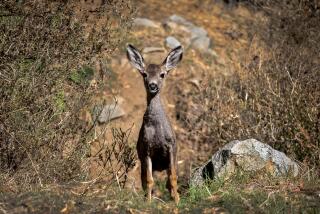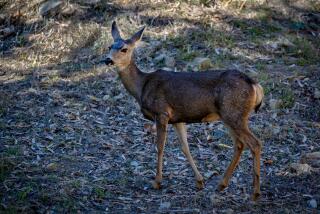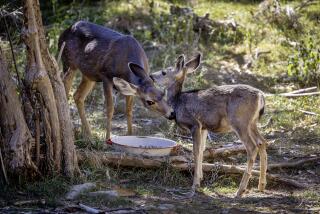Catalina bison going on birth control
- Share via
Reporting from Avalon — Half a dozen men with walkie-talkies and cattle prods set out on foot at sunrise Thursday to coax a herd of 10 feral bison into a corral a mile away at the bottom of a Santa Catalina Island valley.
It wasn’t easy. In the final days of the mating season, a massive bull kept one beady eye on his cows, all of them pregnant, and the other on his human pursuers, who followed close behind shouting and waving their arms as the animals lumbered up steep slopes and into plunging ravines.
It was one of several herding operations that will culminate today with the inoculation of female bison older than 2 years, part of an experimental program designed to limit the population through contraception. The goal: reduce herd size -- which increases by 15% or more each calving season -- to a manageable, healthier, less environmentally damaging and constant 150 or so.
The vaccine is non-hormonal and will not harm the animals or change their social structures, said Carlos de la Rosa, the conservancy’s chief conservation and education officer. It is also reversible after about a year.
“Bison will continue to be bison,” De la Rosa said. “Males will continue to compete for females, and females will continue to go into heat. The only difference is that we can control how many calves they have.
“For bison in love,” he added with a laugh, “this means romance without responsibilities.”
The Catalina Island Conservancy, a nonprofit organization that owns 88% of the island and is charged with preserving its wild state, believes the program will be a cost-effective, socially acceptable and humane method of controlling the herd. In Defense of Animals, an advocacy group, agrees and has donated a quarter of the cost of the $200,000, five-year program.
The idea of using contraception on the bison was first suggested by Debbie Avellana, an Avalon shop owner and animal rights advocate who fiercely resisted earlier efforts to rid the island of nonnative goats and pigs.
“I’m so happy. Our bison don’t have to be shipped out or killed,” she said, “and they will have more to eat.”
The program involves annual injections of the wildlife contraceptive porcine zona pellucida -- PZP for short. When PZP, derived from pig eggs, is injected, it stimulates the immune system to produce antibodies that attach to sperm receptors on the surface of the female’s eggs and distort their shape, thereby preventing fertilization.
“This is the last season the females will become pregnant en masse,” said Ann M. Muscat, president and chief executive of the conservancy. Contraception, she said, “is the next evolution of management strategy.”
That kind of talk worries Darrell Geist, habitat coordinator for the Buffalo Field Campaign, a nonprofit group dedicated to protecting the last wild bison herd in the United States at Yellowstone National Park.
“When you intervene with natural selection,” he said, “you are unraveling a very complex relationship among herd animals, particularly among matriarchal females and bulls who compete for those females.”
The island’s bison are descendants of the 14 shipped here in 1924 to appear in the 1925 silent western “The Vanishing American.” A decade ago, as many as 500 roamed Catalina’s 76 square miles of rugged mountains, lush valleys, streams and grasslands, where the next-largest natural herbivores are ground squirrels.
Locals have come to cherish the shaggy beasts as living symbols of the island’s heritage, and they are a powerful attraction for eco-tourists.
Some homes in Avalon, the island’s tourism and demographic center with a permanent population of about 4,000 people, are festooned with painted images of bison or crowned with bronze bison weather vanes. Gift shops sell furry bison figurines and gold-painted, dehydrated bison droppings.
The Catalina Island Chamber of Commerce & Visitors Bureau sponsored a “Buffalo in Paradise” event in 2003, which featured whimsically decorated fiberglass bison placed outdoors throughout town.
But Catalina only appears to be a hospitable landscape for bison.
In 2003, when there were 350 bison on the island, a scientific survey concluded that “although the bison seem to be doing well, they are significantly smaller than mainland bison, experience relatively low reproductive rates and appear to be in poor nutritional condition, based on blood tests and frequent observations of open sores.”
The health of the bison has significantly improved, conservancy officials said, since the herd numbers were reduced to less than 200 beginning in 2005. They achieved that by sending the bison out for slaughter or to breeding programs elsewhere.
Most recently, however, the animals have been transported, at a cost of $1,000 per animal, to Native American reservation lands in South Dakota to live out their lives.
The study also pointed out that foraging and wallowing bison were trampling native plant communities, altering tree canopies by rubbing against trees, and undermining weed management efforts by dispersing a variety of nonnative grasses through their droppings.
The contraception program is expected to be 90% effective, “so there will be a small percentage that does not respond and becomes impregnated,” De la Rosa said.
In the meantime, the conservancy’s bison wranglers were clambering over the island’s rugged terrain Thursday with a goal of ensuring that every big browser gets a blood test and an ear tag -- and, for females, the contraceptive.
By noon, nearly 50 animals had been rounded up and trucked to a holding facility at conservancy headquarters in the center of the island.
“It’s a lot of exercise for our guys,” said Lenny Altherr, the conservancy’s director of facilities management and trail boss of the roundup.
More to Read
Sign up for Essential California
The most important California stories and recommendations in your inbox every morning.
You may occasionally receive promotional content from the Los Angeles Times.











